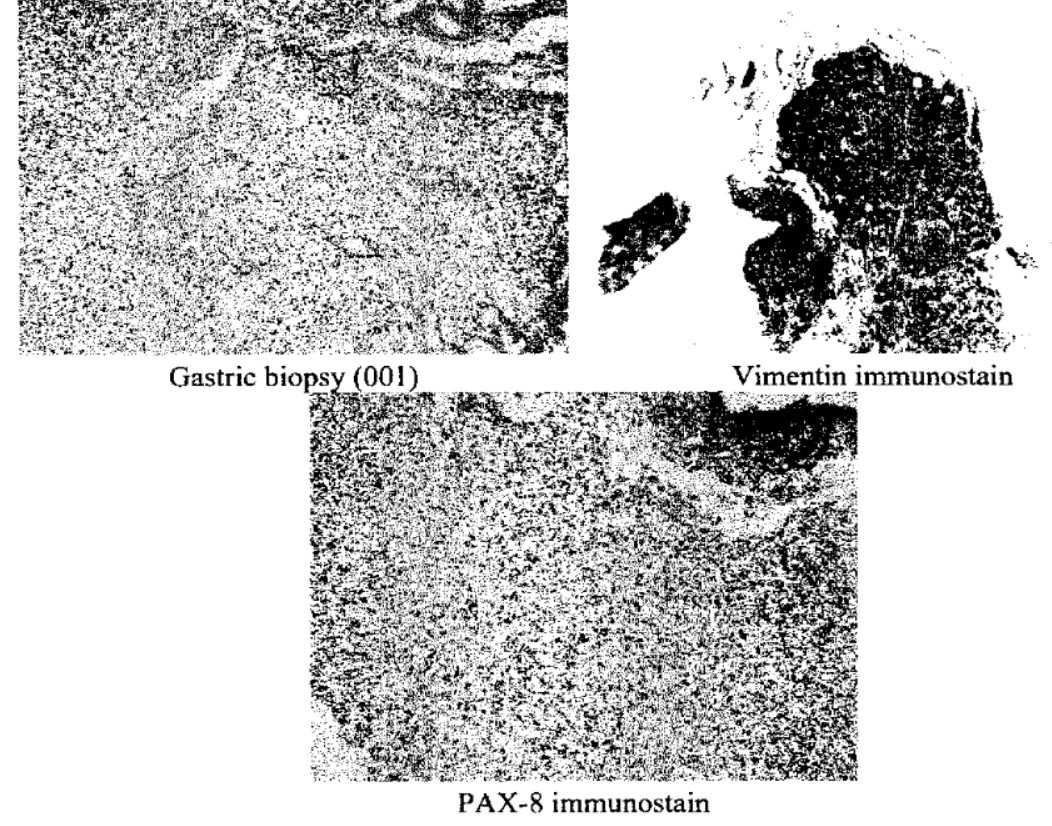Sunday Poster Session
Category: Stomach and Spleen
P2134 - Gastric Ulcer Biopsy Leading to the Diagnosis of Metastatic Clear Cell Malignant Melanoma
Sunday, October 26, 2025
3:30 PM - 7:00 PM PDT
Location: Exhibit Hall

Amna Iftikhar, MD
Rawalpindi Medical University
Tennessee
Presenting Author(s)
Amna Iftikhar, MD1, Nisma Faridi, MD2, Asad Jehangir, MD3, Humberto Sifuentes, MD4
1Rawalpindi Medical University, Rawalpindi, Islamabad, Pakistan; 2Army Medical College, Rawalpindi, Islamabad, Pakistan; 3GI Associates LLC, Ascension Hospital, Milwaukee, WI; 4Augusta University, Augusta, GA
Introduction: About 7% of gastric ulcers are malignant, most commonly due to gastric adenocarcinoma. Other malignant causes including gastric mucosa-associated lymphoid tissue (MALT) lymphoma, and diffuse large B-cell lymphoma. Less than 2% of gastric ulcers are metastatic from other organs. We present a case of stomach ulcer from metastatic clear cell malignant melanoma (CCMM), that because of its clear cell features was initially misdiagnosed as metastatic renal cell cancer.
Case Description/
Methods: A 51-year-old female with no significant past medical history presented with a 4-month history of abdominal cramping, irregular bowel movements, nausea, regurgitation, decreased appetite and 30-pound weight loss. She reported no new medications. Her symptoms prompted an EGD that revealed a 1 cm stellate gastric body ulcer along the greater curvature. Colonoscopy was unremarkable. Gastric ulcer biopsy was positive for PAX-8 and vimentin immunostains suggestive of metastatic clear cell renal carcinoma. CT chest, abdomen and pelvis showed extensive metastases within lung, intra-abdominal masses, peritoneal involvement, bilateral adrenal masses and pathological fracture at T12. CT also showed multiple nodules throughout the subcutaneous tissues of the abdominal wall and lower breast. No definite renal lesions were identified. MRI brain showed multiple metastatic lesions in the cerebellum, hypothalamus and several brain regions. Biopsy of the subcutaneous mass from the back confirmed the CCMM. The gastric ulcer biopsy, initially suspected to be metastatic renal cell, was actually CCMM.
Patient was treated with brain radiation followed by combination immunotherapy with ipilimumab and nivolumab. Given the lack of response, targeted therapy with dabrafenib and trametinib was recommended. However, due to the poor prognosis, patient opted for hospice care.
Discussion: CCMM is an extremely rare variant of melanoma. It can present with unusual metastatic patterns, including the involvement of the gastrointestinal tract, posing diagnostic challenges. Presence of clear cell features on gastric ulcer biopsy should raise suspicion of CCMM, especially in the absence of obvious renal lesions on imaging.
Accurate diagnosis relies on a high index of suspicion and careful pathologic correlation. Despite available systemic therapies, the prognosis remains poor, particularly in immunotherapy-refractory cases.

Figure: Figure 1.: Gastric biopsy results showing clear cells with glycogen and immunohistochemical staining
positive for PAX-8 and Vimentin immunostains suggestive of metastatic clear cell renal carcinoma.
Disclosures:
Amna Iftikhar indicated no relevant financial relationships.
Nisma Faridi indicated no relevant financial relationships.
Asad Jehangir indicated no relevant financial relationships.
Humberto Sifuentes indicated no relevant financial relationships.
Amna Iftikhar, MD1, Nisma Faridi, MD2, Asad Jehangir, MD3, Humberto Sifuentes, MD4. P2134 - Gastric Ulcer Biopsy Leading to the Diagnosis of Metastatic Clear Cell Malignant Melanoma, ACG 2025 Annual Scientific Meeting Abstracts. Phoenix, AZ: American College of Gastroenterology.
1Rawalpindi Medical University, Rawalpindi, Islamabad, Pakistan; 2Army Medical College, Rawalpindi, Islamabad, Pakistan; 3GI Associates LLC, Ascension Hospital, Milwaukee, WI; 4Augusta University, Augusta, GA
Introduction: About 7% of gastric ulcers are malignant, most commonly due to gastric adenocarcinoma. Other malignant causes including gastric mucosa-associated lymphoid tissue (MALT) lymphoma, and diffuse large B-cell lymphoma. Less than 2% of gastric ulcers are metastatic from other organs. We present a case of stomach ulcer from metastatic clear cell malignant melanoma (CCMM), that because of its clear cell features was initially misdiagnosed as metastatic renal cell cancer.
Case Description/
Methods: A 51-year-old female with no significant past medical history presented with a 4-month history of abdominal cramping, irregular bowel movements, nausea, regurgitation, decreased appetite and 30-pound weight loss. She reported no new medications. Her symptoms prompted an EGD that revealed a 1 cm stellate gastric body ulcer along the greater curvature. Colonoscopy was unremarkable. Gastric ulcer biopsy was positive for PAX-8 and vimentin immunostains suggestive of metastatic clear cell renal carcinoma. CT chest, abdomen and pelvis showed extensive metastases within lung, intra-abdominal masses, peritoneal involvement, bilateral adrenal masses and pathological fracture at T12. CT also showed multiple nodules throughout the subcutaneous tissues of the abdominal wall and lower breast. No definite renal lesions were identified. MRI brain showed multiple metastatic lesions in the cerebellum, hypothalamus and several brain regions. Biopsy of the subcutaneous mass from the back confirmed the CCMM. The gastric ulcer biopsy, initially suspected to be metastatic renal cell, was actually CCMM.
Patient was treated with brain radiation followed by combination immunotherapy with ipilimumab and nivolumab. Given the lack of response, targeted therapy with dabrafenib and trametinib was recommended. However, due to the poor prognosis, patient opted for hospice care.
Discussion: CCMM is an extremely rare variant of melanoma. It can present with unusual metastatic patterns, including the involvement of the gastrointestinal tract, posing diagnostic challenges. Presence of clear cell features on gastric ulcer biopsy should raise suspicion of CCMM, especially in the absence of obvious renal lesions on imaging.
Accurate diagnosis relies on a high index of suspicion and careful pathologic correlation. Despite available systemic therapies, the prognosis remains poor, particularly in immunotherapy-refractory cases.

Figure: Figure 1.: Gastric biopsy results showing clear cells with glycogen and immunohistochemical staining
positive for PAX-8 and Vimentin immunostains suggestive of metastatic clear cell renal carcinoma.
Disclosures:
Amna Iftikhar indicated no relevant financial relationships.
Nisma Faridi indicated no relevant financial relationships.
Asad Jehangir indicated no relevant financial relationships.
Humberto Sifuentes indicated no relevant financial relationships.
Amna Iftikhar, MD1, Nisma Faridi, MD2, Asad Jehangir, MD3, Humberto Sifuentes, MD4. P2134 - Gastric Ulcer Biopsy Leading to the Diagnosis of Metastatic Clear Cell Malignant Melanoma, ACG 2025 Annual Scientific Meeting Abstracts. Phoenix, AZ: American College of Gastroenterology.
